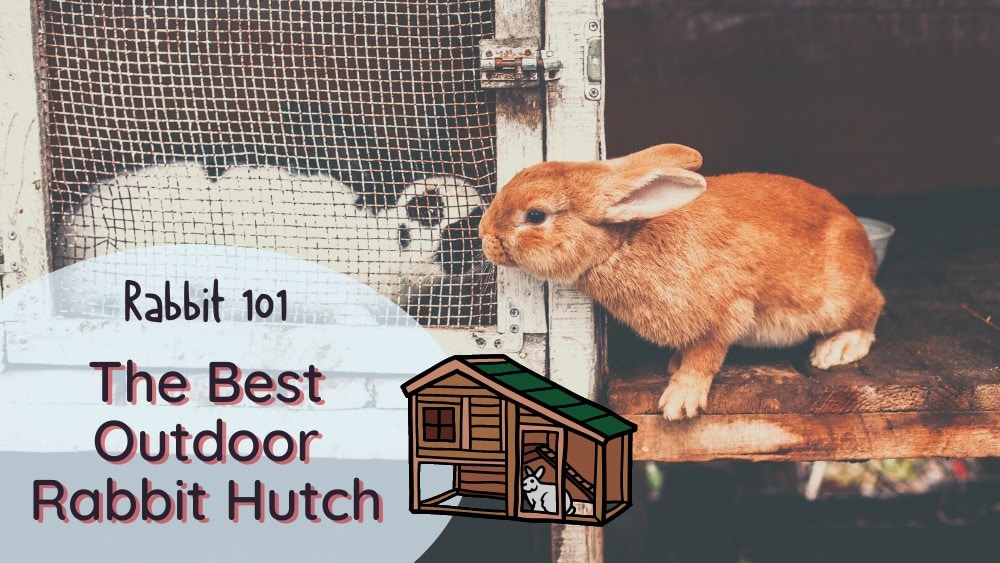House rabbits are increasingly popular, but they have drawbacks. They do smell (at least a little) and they make a mess with their hay. They chew pretty much everything in sight. These are a few reasons why you might prefer to keep a rabbit outdoors. Or you might have a family member with allergies, and an outdoor rabbit is your only option.
I got my first bunny when I was 11, and my mom never once allowed him into the house. I continued to keep outdoor rabbits until I was an adult and had my own home with my own rules. So I learned how to keep bunnies safe outside, and – to be honest –I made some mistakes.
From my experience, I can say with conviction that most commercially available rabbit hutches are not safe for outdoor rabbits!
In this post, we’ll explore the controversial topic of whether pet rabbits can live outside and recommend the best hutches to give outdoor bunnies a secure and enriching life.
Can Pet Rabbits Live Outside?
Pet rabbits can live outdoors in climates that don’t get too hot or cold, as long as they have a properly-built hutch. The hutch must protect them from rain, wind, and extreme temperatures. It must be absolutely predator-proof, and locked to keep well-meaning humans from opening it. Meeting these criteria while also giving a rabbit enough room to exercise and using easy-to-clean materials is more of a challenge than you’d think.
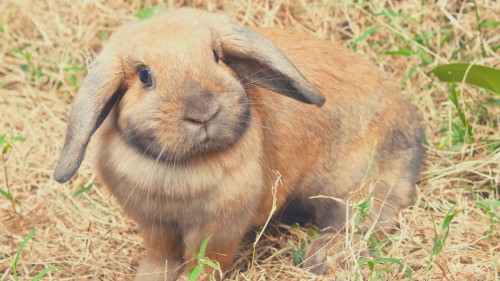
The Risks of Keeping Rabbits Outdoors
The great outdoors is a dangerous place for rabbits. Near the bottom of the food chain, few wild rabbits survive to adulthood. Those that do only live one or two years.
Pet rabbits can live much longer than that!
According to the House Rabbit Society, the life expectancy for spayed or neutered rabbits kept in ideal indoor conditions is 8-14 years.
On the other hand, outdoor rabbits kept in a hutch live an average of 5-7 years. This leads many rabbit advocates to say that rabbits should never be kept outdoors in a hutch.
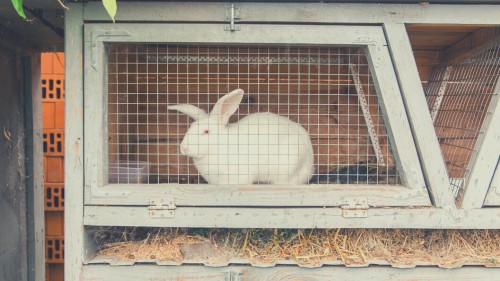
But let’s look more closely at the reasons why outdoor rabbits don’t live as long, and how to avoid them. I had an outdoor female rabbit, Button, that lived to age 12 – so it’s possible to beat the odds.
Threats from Weather and Environment
Many people wonder if rabbits can live outdoors in the winter. Our website has an in-depth answer to that question, but the short version is that, yes – in most climates, they can. Adult rabbits that live outdoors year-round and have time to grow thick coats can survive in surprisingly low temperatures as long as they have enough food and fresh water.
Summer weather, on the other hand, can kill them quickly.
Heat and humidity can send a rabbit into heat stroke, even if they live in the shade. Direct sunlight can cause sunstroke, even if the air temperature is relatively cool.
Rabbit cages should always be kept in the shade, and if the air temperature rises above 80 degrees Fahrenheit (26.6 Celsius) you need to take measures to cool your rabbit off.
We don’t have space to go into the details of how to protect outdoor rabbits from the weather in this article.
In brief: you need to make sure that they stay dry and out of the wind at all times – while not boxing them in so much that there’s no ventilation in the hutch.
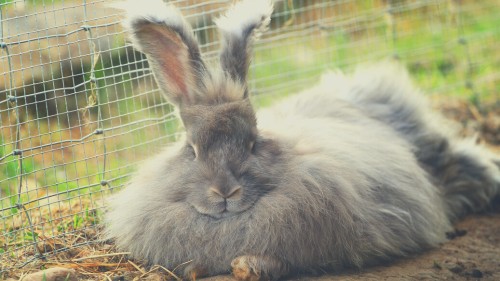
Threats from People and Other Animals
If the neighbor kids discover that you have pet rabbits in the backyard, you may have unwelcome visitors. Kids might feed your bunny poisonous weeds through the wire or leave the cage door open. In some areas of the world, theft is the biggest challenge to keeping rabbits outside.
Wild animals are more ruthless. Raccoons can open latches. Coyotes can tear apart wire that’s stapled to wood. Dogs can kill rabbits through wire floors, or bark until a bunny dies from fright. If you have an open pen for your rabbits to run on the grass, you risk attack from birds of prey.
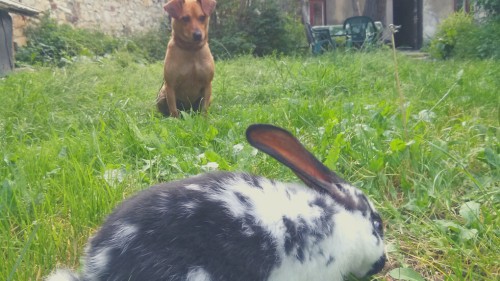
I’ve been in the rabbit information world for 20 years, and I receive terrible reports like these from devastated pet owners way too often. Don’t cut corners with your rabbit hutch.
Requirements for a Safe Outdoor Rabbit Hutch
I have several non-negotiable criteria for outdoor rabbit hutches that rabbits live in full time.
- Wire parts must be made of 14 or 16-gauge (thick!) galvanized wire. No poultry netting. Mesh must be 1×2” at the largest. The floor must be ½” x 1 or ½” x ½” mesh. If the wire is secured to wood, it must be VERY secure.
- Wood parts must be made of chew-safe material (not cedar) and thick enough that rabbits cannot chew through them. Inspect your hutch regularly, since rabbits can gnaw through a 2×4 in a few weeks.
- The floor of the cage must be solid. If you use a cage with a wire floor, use a drop tray underneath and give the rabbit a nesting box with a solid floor inside the cage.
- The cage must be raised at least 3 feet (1 meter) off the ground. Rabbits kept on the ground are at risk of attack from weasels, opossums, foxes, and more.
- The door must be latched and locked.
- Rabbits should only be allowed out to exercise when supervised. It would be wonderful to give rabbits full-time access to a pen on the grass, but it’s not safe outside. The hutch itself needs to be large enough for a rabbit to get some exercise, in addition to its supervised playtime outside.
Keeping Rabbits in a Shed, Barn, or Fenced Yard
Does keeping a rabbit outdoors sound riskier than it’s worth? A great alternative is to keep your rabbit hutch in a shed or a barn. Barns protect bunnies from wind, rain, and temperature extremes. They can also provide security from predators – but they need to be VERY secure. (I had raccoons sneak under a 6” high gap in my shed door. Awful.)
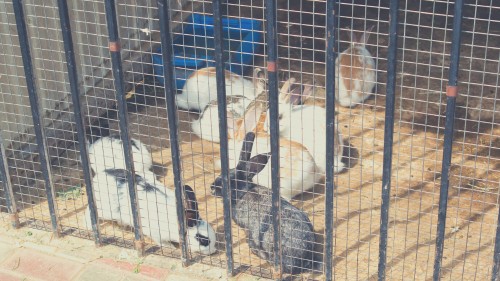
Fenced yards may provide protection from humans, dogs, or larger predators, but smaller ones still have access. Don’t let your guard down just because your yard is fenced.
Quality of Care
The biggest reason why outdoor rabbits don’t live as long on average is that they often aren’t given the same standard of care as indoor bunnies. Sadly, outdoor rabbits are more likely to be neglected or forgotten. If there’s a blizzard outside, for example, the owner may not bother to go out and feed the rabbit or make sure it has water that isn’t frozen. People can have very callous attitudes towards rabbits, thinking things like, “oh, they can just eat snow.”
Many people believe the terrible idea that rabbits are disposable. They may even take a “survival of the fittest” mentality, and say, “If a rabbit can’t handle the weather, I don’t want it in my herd.” Historically, most female rabbits kept outdoors have been bred frequently, or at least are not spayed. Spaying female rabbits prevents the uterine cancer that causes the early death of so many pet bunnies.
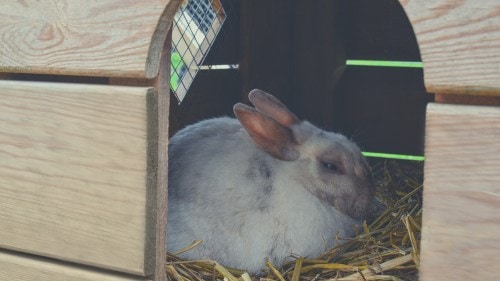
All this to say – if you treat your outdoor rabbit right, it has a much better shot at thriving. Give it the best food possible, feed and water it on a regular schedule, and provide proper medical care, and your outdoor bunny can live to a great old age.
What is the Best Hutch for Outdoor Rabbits?
Now that we know what to look for, let’s review some hutches for outdoor bunnies. Remember, your rabbit will be safest if the hutch is placed in a barn rather than in the open. You could also choose to keep your rabbit outdoors in one of these fun, spacious cages during the day when you can keep an eye on it and move it to a smaller, more secure cage in a barn at night.
Best Outdoor Rabbit Hutch – KinPaws 74″ Extra Large Bunny Cage

| Star Rating: | 4.0⭐ |
| Size: | 74″L x 17″W x 33″H |
| Materials: | Softwood, wire mesh, asphalt roof |
There’s a lot to love about the KinPaws 74” Rabbit Hutch – but it has its limits. On the pro side, it’s roomy enough for one or two bunnies to have ample space to play. It’s aesthetically pleasing and has a pull-out tray for easy cleaning. I like the closed “upper room” where rabbits can retreat for privacy and safety, while the rest of the hutch has excellent ventilation. Overall, I love the concept of this hutch.
I do have concerns about the quality of its construction. If you read the reviews on Amazon, you’ll see that many of the positive reviews are using it to house quail or chickens – not rabbits. The wire may not be sturdy enough to keep out predators, and the fir wood may not hold up to gnawing.
Still, there are so few good options for outdoor rabbit hutches that I’d consider this one of the best. It may not be suitable for outdoor use in areas where there’s a high risk of predators or bad weather. This would work very well as a daytime habitat for bunnies who have a more secure home at night.
What We Like
- Asphalt roof.
- Fir wood is finished with non-toxic varnish.
- Enriching design gives rabbits a chance to dig, run, play, climb, and hide.
- Roomy enough for multiple bunnies.
- Open bottom allows rabbits to graze.

What We Don’t Like
- Most of the cage doesn’t provide protection from weather.
- Very difficult for the owner to catch a rabbit in this cage.
- Open floor means predators (and rabbits themselves) can dig under it.
- Will probably only last a few years.
Best Outdoor Rabbit Hutch with a Run – Aivituvin 103.2″ Long Rabbit Hutch with Run

| Star Rating: | 4.0⭐ |
| Size: | 103.2″L x 25.2″W x 36.2″H |
| Materials: | Fir wood, wire, asphalt |
Created by putting two smaller hutches and runs together, the Aivituvin 103.2” Long Rabbit Hutch is a bunny’s dream playground. It has two fully closed-in nesting spaces and a long run where rabbits can get up enough speed for a binky jump. With a good quality asphalt roof, this is another good option for daytime use for outdoor bunnies. Since there are so many opening doors on this product, it’s easier to access the bunny inside than it is in other models.
Its drawbacks are similar to other softwood commercial hutches. Ease of cleaning and durability of materials are concerns.
What We Like
- Natural wood material looks pleasing in the yard.
- Long run where rabbits can exercise and enjoy the outdoors
- Elevated closed-in room for security (would be great if you can lock this to keep the bunny inside.)
- Good ventilation

What We Don’t Like
- Lower portions of the cage won’t protect a rabbit from predators.
- Rabbits would get wet in the rain.
- Not adequate protection for winter use in cold climates.
Best Affordable Outdoor Rabbit Hutch – Trixie Nautra 1 Story Outdoor Rabbit Hutch, Large
| Star Rating: | 3.5⭐ |
| Size: | 45.5 x 36 x 24.75″ |
| Materials: | Fir wood, plastic, wire |
If you need a quick solution for your rabbit while you wait to DIY a stronger hutch, the Trixie Natura 1-Story Outdoor Hutch can serve the purpose. I like its long legs and solid floor, even if that can make things difficult to clean. This one offers better predator protection than the models we described above – as long as you reinforce the floor to make sure it doesn’t fall through the bottom frame. This hutch protects rabbits from rain and wind, but doesn’t offer enough ventilation for hot summers.
What We Like
- Cage is elevated on the legs.
- Solid floor with slide-out tray.
- Protection on 5.5 sides, if at the cost of good ventilation.
What We Don’t Like
- Small for multiple rabbits.
- Bottom is not strong enough for very heavy bunnies.
- Like the other hutches available, it’s made of inexpensive wood.
Building Your Own Outdoor Rabbit Hutch
Your rabbit may be safest if you build your own rabbit hutch out of high-quality materials. There are lots of good rabbit hutch plans available online (and quite a few bad ones, too!) I like the DIY Rabbit Hutch Plans from Construct101. The hutch in the plans keeps rabbits elevated off the ground. One side has great ventilation for warmer days, and the other side is well-insulated.
When building your own rabbit hutch, never use chemical-treated wood in places that rabbits can chew.
Other Helpful Supplies for Outdoor Rabbits
- Nesting Box. I recommend giving all outdoor rabbits a wood nesting box with a solid bottom, so they have a safe place to hide. This will comfort them from scary noises and give them an extra layer of protection from predators.
- High-Quality Bedding. Good bedding like Carefresh or clean straw will help a rabbit feel warm and safe in its nest box.
- Hutch Cover. After years of covering hutches with tarps and quilts that would get soggy, I was amazed to discover that hutch covers are a thing now! These are both insulating and protect rabbits from wind, especially when paired with a mylar blanket. You can remove them on nice days for good ventilation.

- Weather-Resistant Water Bowls. If you keep a rabbit outside when the temps dip below freezing, you’ll need some weather-resistant or even heated water bowls.
- Ceramic Tiles. Ceramic tiles are great for keeping bunnies cool in hot weather. Freeze them and then place them in the cage so your bunny can stretch out alongside them.
- Storage Shed. Outdoor rabbits are safest if kept in a storage shed or a barn, but it needs to be the right kind of outbuilding. Plastic storage sheds heat up like an oven, especially if they don’t have windows. Stick construction pole buildings with windows work the best. You may need to place box fans in them for ventilation. Some breeders even run air conditioning in their bunny barns.
- Locks. Keep rabbits in and unwanted hands out.

Important! Be VERY careful when using heated bowls, heat mats, heat lamps, or anything with cords outdoors in a rabbit’s area. Rabbits can chew cords, and keeping electrical appliances outdoors in wet weather near flammable rabbit bedding is a recipe for danger.
I experienced this firsthand. When I was a kid, a heating mat nearly caught my hutch on fire. Thankfully my dad saw the spark out the window and put it out. No one was harmed, but my bunny’s fur smelled like smoke for days.
Maintain Your Outdoor Rabbit Hutch
Remember that outdoor rabbit hutches will need occasional maintenance to stay safe. Wood can swell and wire can rust if it’s not properly galvanized. Inspect your outdoor rabbit enclosure regularly for warped or chewed wood, bent wire, rusty latches, or loose staples.
Frequently Asked Questions
How Big Should a Hutch Be for One Rabbit?
The smallest bunnies should get a hutch that’s at least 36” long by 24” wide, and tall enough for them to stand upright. For larger rabbits, shoot for at least one square foot of floor space per pound of a rabbit’s body weight. This assumes bunnies will get to leave the hutch daily for exercise.
Can Bunnies Sleep Outside in a Hutch?
Rabbits can sleep outside in a hutch if it is absolutely predator-safe, as described in this article. However, most mail-order hutches aren’t strong enough to protect bunnies. You can build a good quality hutch yourself, or place the hutch in a barn. Rabbits also need to be protected from rain. A wet bunny can quickly develop chills or shock and is at risk for fly strike.
In What Temperature Can Bunnies Sleep Outside?
Wrapped in a fur coat, rabbits can sleep outside in temperatures that get down to 20 degrees Fahrenheit. This assumes that rabbits are protected from drafts and wind, stay totally dry, and have a snug nesting box. When the nighttime temperatures hit the teens or single-digits, you may want to bring your rabbit inside for the night.
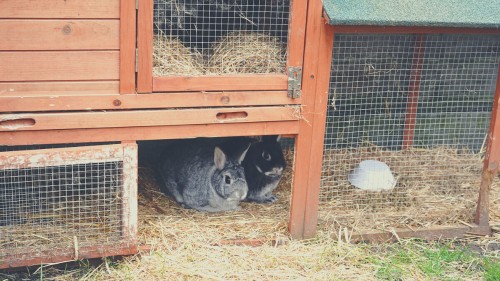
If you adopt a bunny that is used to living indoors, introduce it slowly to life outside. Do not drop a rabbit used to indoor temperatures into a freezing hutch – or a very hot and sticky one. The shock of the adjustment could be fatal for your bunny.
Conclusion
While it sounds idyllic for rabbits to live in a decorative cottage-like rabbit hutch with room to romp on the grass, it’s not always practical.
If you have a very safe backyard, live in a mild climate, and want to let a bunny play outside during the day only, the KinPaws 74″ Extra Large Bunny Cage is a great option. If you want to keep a rabbit outdoors night or year-round, you may have to build a suitable hutch yourself.

There are many different opinions in the pet rabbit community about keeping bunnies outdoors. We believe that everyone reading this site wants the best for their rabbits. Bearing in mind that everyone has different living conditions and restrictions, please stay kind in the comments. 🙂


